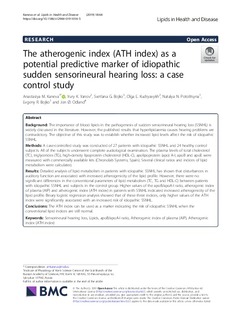| dc.contributor.author | Kaneva, Anastasiya M. | |
| dc.contributor.author | Yanov, Yury K | |
| dc.contributor.author | Bojko, Svetlana G | |
| dc.contributor.author | Kudryavykh, Olga E | |
| dc.contributor.author | Potolitsyna, Natalya N. | |
| dc.contributor.author | Bojko, Evgeny R. | |
| dc.contributor.author | Odland, Jon Øyvind | |
| dc.date.accessioned | 2019-09-30T07:01:41Z | |
| dc.date.available | 2019-09-30T07:01:41Z | |
| dc.date.created | 2019-07-23T16:54:56Z | |
| dc.date.issued | 2019 | |
| dc.identifier.citation | Lipids in Health and Disease. 2019, 18 (64), 1-7. | nb_NO |
| dc.identifier.issn | 1476-511X | |
| dc.identifier.uri | http://hdl.handle.net/11250/2619263 | |
| dc.description.abstract | Background
The importance of blood lipids in the pathogenesis of sudden sensorineural hearing loss (SSNHL) is widely discussed in the literature. However, the published results that hyperlipidaemia causes hearing problems are contradictory. The objective of this study was to establish whether increased lipid levels affect the risk of idiopathic SSNHL.
Methods
A case-controlled study was conducted of 27 patients with idiopathic SSNHL and 24 healthy control subjects. All of the subjects underwent complete audiological examination. The plasma levels of total cholesterol (TC), triglycerides (TG), high-density lipoprotein cholesterol (HDL-C), apolipoprotein (apo) A-I, apoB and apoE were measured with commercially available kits (Chronolab Systems, Spain). Several clinical ratios and indices of lipid metabolism were calculated.
Results
Detailed analysis of lipid metabolism in patients with idiopathic SSNHL has shown that disturbances in auditory function are associated with increased atherogenicity of the lipid profile. However, there were no significant differences in the conventional parameters of lipid metabolism (TC, TG and HDL-C) between patients with idiopathic SSNHL and subjects in the control group. Higher values of the apoB/apoA-I ratio, atherogenic index of plasma (AIP) and atherogenic index (ATH index) in patients with SSNHL indicated increased atherogenicity of the lipid profile. Binary logistic regression analysis showed that of these three indices, only higher values of the ATH index were significantly associated with an increased risk of idiopathic SSNHL.
Conclusions
The ATH index can be used as a marker indicating the risk of idiopathic SSNHL when the conventional lipid indices are still normal. | nb_NO |
| dc.language.iso | eng | nb_NO |
| dc.publisher | BioMed Central | nb_NO |
| dc.rights | Navngivelse 4.0 Internasjonal | * |
| dc.rights.uri | http://creativecommons.org/licenses/by/4.0/deed.no | * |
| dc.title | The atherogenic index (ATH index) as a potential predictive marker of idiopathic sudden sensorineural hearing loss: a case control study | nb_NO |
| dc.type | Journal article | nb_NO |
| dc.type | Peer reviewed | nb_NO |
| dc.description.version | publishedVersion | nb_NO |
| dc.source.pagenumber | 1-7 | nb_NO |
| dc.source.volume | 18 | nb_NO |
| dc.source.journal | Lipids in Health and Disease | nb_NO |
| dc.source.issue | 64 | nb_NO |
| dc.identifier.doi | 10.1186/s12944-019-1016-5 | |
| dc.identifier.cristin | 1712513 | |
| dc.description.localcode | Open Access This article is distributed under the terms of the Creative Commons Attribution 4.0 International License (http://creativecommons.org/licenses/by/4.0/), which permits unrestricted use, distribution, and reproduction in any medium, provided you give appropriate credit to the original author(s) and the source, provide a link to the Creative Commons license, and indicate if changes were made. | nb_NO |
| cristin.unitcode | 194,65,0,0 | |
| cristin.unitname | Fakultet for medisin og helsevitenskap | |
| cristin.ispublished | true | |
| cristin.fulltext | original | |
| cristin.qualitycode | 1 | |

